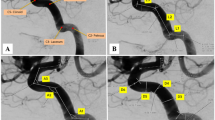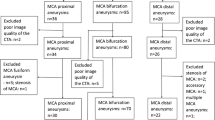Abstract
Purpose
The purpose of this study is to investigate the morphometric properties of the internal carotid artery (ICA) by measuring the diameters and angles of its segments and exploring variations related to sex and the presence of aneurysms.
Methods
Digital subtraction angiography (DSA) images were utilized from 130 aneurysm patients and 75 non-aneurysm individuals to create 3D ICA models using 3D Slicer software. Segment diameters were measured via Autodesk Meshmixer 3.5.474 and angles were evaluated using ImageJ software.
Results
In total, DSA images of 130 aneurysm patients and 75 individuals with normally reported carotid systems were evaluated. It was found that the intracranial aneurysms (IAs) were predominantly formed on the anterior cerebral artery (ACA) in males (%43), whereas in females IAs were frequently localized in the C6 segment (31.7%) and middle cerebral artery (MCA) (30.2%). In the control group, the evaluation of gender differences in segment diameters and angles revealed that males had significantly larger C4 and C5 segment diameters (4.62 vs. 4.32 mm and 4.41 vs. 4.09 mm, respectively) and a greater C6 angle (146.9° vs. 139.7°) compared to females. Comparisons between patients with an aneurysm at the anterior cerebral artery (ACA) and the control group revealed that the ACA group had wider diameters in the C1 (4.88 vs. 4.53 mm), C3 (4.65 vs. 4.4 mm), C5 (4.51 vs. 4.25 mm), and ACA (2.36 vs. 2.06 mm) segments. Additionally, the ACA group had wider angles in the ACA (104.1° vs. 94.1°) and C6 segments (147.7° vs. 143.3°), whereas the control group exhibited wider angles in the middle cerebral artery (MCA) segment (141.5° vs. 135.5°) compared to the ACA aneurysm group. Patients with anterior cerebral artery (ACA) aneurysms exhibited larger diameters in C1, C3, C5, C6, and ACA segments compared to the control group. Additionally, while the control group had larger MCA angle, patients with ACA aneurysms had larger angles in C6 segment and ACA.
Conclusion
Our results demonstrated that formation of aneurysms is affected by anatomical configuration of the ICA as well as sex characteristics, particularly regarding the ACA and MCA bifurcation angles, which showed associations with aneurysms in the respective branches.




Similar content being viewed by others
Data availability
Not applicable.
References
Baharoglu MI, Schirmer CM, Hoit DA, Gao BL, Malek AM (2010) Aneurysm inflow-angle as a discriminant for rupture in sidewall cerebral aneurysms: morphometric and computational fluid dynamic analysis. Stroke 41(7):1423–1430. https://doi.org/10.1161/strokeaha.109.570770
Bouthillier A, van Loveren HR, Keller JT (1996) Segments of the internal carotid artery: a new classification. Neurosurgery 38(3):425–432; discussion 432–423. https://doi.org/10.1097/00006123-199603000-00001
Caranci F, Briganti F, Cirillo L, Leonardi M, Muto M (2013) Epidemiology and genetics of intracranial aneurysms. Eur J Radiol 82(10):1598–1605. https://doi.org/10.1016/j.ejrad.2012.12.026
Castro MA, Putman CM, Cebral JR (2006) Computational fluid dynamics modeling of intracranial aneurysms: effects of parent artery segmentation on intra-aneurysmal hemodynamics. AJNR Am J Neuroradiol 27(8):1703–1709
Cebral JR, Castro MA, Burgess JE, Pergolizzi RS, Sheridan MJ, Putman CM (2005) Characterization of cerebral aneurysms for assessing risk of rupture by using patient-specific computational hemodynamics models. AJNR Am J Neuroradiol 26(10):2550–2559
Chistiakov DA, Orekhov AN, Bobryshev YV (2017) Effects of shear stress on endothelial cells: go with the flow. Acta Physiol (Oxf) 219(2):382–408. https://doi.org/10.1111/apha.12725
Detmer FJ, Chung BJ, Jimenez C, Hamzei-Sichani F, Kallmes D, Putman C, Cebral JR (2019) Associations of hemodynamics, morphology, and patient characteristics with aneurysm rupture stratified by aneurysm location. Neuroradiology 61(3):275–284. https://doi.org/10.1007/s00234-018-2135-9
Duan Z, Li Y, Guan S, Ma C, Han Y, Ren X, Wei L, Li W, Lou J, Yang Z (2018) Morphological parameters and anatomical locations associated with rupture status of small intracranial aneurysms. Sci Rep 8(1):6440. https://doi.org/10.1038/s41598-018-24732-1
Etminan N, Rinkel GJ (2015) Cerebral aneurysms: Cerebral aneurysm guidelines—more guidance needed. Nat Rev Neurol 11(9):490–491. https://doi.org/10.1038/nrneurol.2015.146
Fedorov A, Beichel R, Kalpathy-Cramer J, Finet J, Fillion-Robin J-C, Pujol S, Bauer C, Jennings D, Fennessy F, Sonka M (2012) 3D Slicer as an image computing platform for the Quantitative Imaging Network. Magn Reson Imaging 30(9):1323–1341
Hoi Y, Meng H, Woodward SH, Bendok BR, Hanel RA, Guterman LR, Hopkins LN (2004) Effects of arterial geometry on aneurysm growth: three-dimensional computational fluid dynamics study. J Neurosurg 101(4):676–681. https://doi.org/10.3171/jns.2004.101.4.0676
Humphrey JD, Taylor CA (2008) Intracranial and abdominal aortic aneurysms: similarities, differences, and need for a new class of computational models. Annu Rev Biomed Eng 10:221–246. https://doi.org/10.1146/annurev.bioeng.10.061807.160439
Kongable GL, Lanzino G, Germanson TP, Truskowski LL, Alves WM, Torner JC, Kassell NF (1996) Gender-related differences in aneurysmal subarachnoid hemorrhage. J Neurosurg 84(1):43–48. https://doi.org/10.3171/jns.1996.84.1.0043
Koo TK, Li MY (2016) A guideline of selecting and reporting intraclass correlation coefficients for reliability research. J Chiropr Med 15(2):155–163. https://doi.org/10.1016/j.jcm.2016.02.012
Krejza J, Arkuszewski M, Kasner SE, Weigele J, Ustymowicz A, Hurst RW, Cucchiara BL, Messe SR (2006) Carotid artery diameter in men and women and the relation to body and neck size. Stroke 37(4):1103–1105. https://doi.org/10.1161/01.STR.0000206440.48756.f7
Krzyżewski RM, Kliś KM, Kucala R, Polak J, Kwinta BM, Starowicz-Filip A, Stachura K, Piszczek K, Moskała M, Tomaszewski KA (2018) Intracranial aneurysm distribution and characteristics according to gender. Br J Neurosurg 32(5):541–543. https://doi.org/10.1080/02688697.2018.1518514
Lindekleiv HM, Valen-Sendstad K, Morgan MK, Mardal KA, Faulder K, Magnus JH, Waterloo K, Romner B, Ingebrigtsen T (2010) Sex differences in intracranial arterial bifurcations. Gend Med 7(2):149–155. https://doi.org/10.1016/j.genm.2010.03.003
Longstreth WT, Nelson LM, Koepsell TD, van Belle G (1994) Subarachnoid hemorrhage and hormonal factors in women. A population-based case-control study. Ann Intern Med 121(3):168–173. https://doi.org/10.7326/0003-4819-121-3-199408010-00002
Mahrous SA, Sidik NAC, Saqr KM (2021) Numerical study on the energy cascade of pulsatile Newtonian and power-law flow models in an ICA bifurcation. PLoS ONE 16(1):e0245775. https://doi.org/10.1371/journal.pone.0245775
Meng H, Tutino VM, Xiang J, Siddiqui A (2014) High WSS or low WSS? Complex interactions of hemodynamics with intracranial aneurysm initiation, growth, and rupture: toward a unifying hypothesis. AJNR Am J Neuroradiol 35(7):1254–1262. https://doi.org/10.3174/ajnr.A3558
Nieuwkamp DJ, Setz LE, Algra A, Linn FH, de Rooij NK, Rinkel GJ (2009) Changes in case fatality of aneurysmal subarachnoid haemorrhage over time, according to age, sex, and region: a meta-analysis. Lancet Neurol 8(7):635–642. https://doi.org/10.1016/s1474-4422(09)70126-7
Nixon AM, Gunel M, Sumpio BE (2010) The critical role of hemodynamics in the development of cerebral vascular disease. J Neurosurg 112(6):1240–1253. https://doi.org/10.3171/2009.10.Jns09759
Piccinelli M, Bacigaluppi S, Boccardi E, Ene-Iordache B, Remuzzi A, Veneziani A, Antiga L (2011) Geometry of the internal carotid artery and recurrent patterns in location, orientation, and rupture status of lateral aneurysms: an image-based computational study. Neurosurgery 68(5):1270–1285; discussion 1285. https://doi.org/10.1227/NEU.0b013e31820b5242
Rasband W (2007) ImageJ, US national institutes of health. http://rsb.info.nih.gov/ij/(1997–2007)
Roi DP, Mueller JD, Lobotesis K, McCague C, Memarian S, Khan F, Mankad K (2019) Intracranial aneurysms: looking beyond size in neuroimaging: the role of anatomical factors and haemodynamics. Quant Imaging Med Surg 9(4):537–545. https://doi.org/10.21037/qims.2019.03.19
Schulz UG, Rothwell PM (2001) Sex differences in carotid bifurcation anatomy and the distribution of atherosclerotic plaque. Stroke 32(7):1525–1531. https://doi.org/10.1161/01.str.32.7.1525
Zhang X-J, Li C-H, Hao W-L, Zhang D-H, Ren C-F, Gao B-L (2018) Enlarged anterior cerebral artery bifurcation angles may induce abnormally enhanced hemodynamic stresses to initiate aneurysms. World Neurosurg 120:e783–e791. https://doi.org/10.1016/j.wneu.2018.08.167
Acknowledgements
The authors sincerely thank to technical staff of the Cukurova University Department of Radiology for their technical support and contribution to the collection of DSA dataset.
Funding
This research did not receive any specific grant from funding agencies in the public, commercial, or not-for-profit sectors.
Author information
Authors and Affiliations
Contributions
Conceptualization: [YC]; Methodology: [YC], [HBO]; Formal analysis and investigation: [SPY], [YC]; Writing—original draft preparation: [YC]; Writing—review and editing: [HE], [YC]; Resources: [HBO]; Supervision: [EDK], [OO]; Visualization: [YC].
Corresponding author
Ethics declarations
Conflict of interest
All authors declare that they have no conflict of interest.
Ethics approval
Ethical approval was waived by the local Ethics Committee of Cukurova University in view of the retrospective nature of the study and all the procedures being performed were part of the routine care (Protocol no: 6.12.2019/94-18).
Additional information
Publisher's Note
Springer Nature remains neutral with regard to jurisdictional claims in published maps and institutional affiliations.
Rights and permissions
Springer Nature or its licensor (e.g. a society or other partner) holds exclusive rights to this article under a publishing agreement with the author(s) or other rightsholder(s); author self-archiving of the accepted manuscript version of this article is solely governed by the terms of such publishing agreement and applicable law.
About this article
Cite this article
Cevik, Y., Onan, H.B., Erdem, H. et al. Investigation of the morphometric characteristics of internal carotid artery between sexes and in patients with intracranial aneurysms. Surg Radiol Anat (2024). https://doi.org/10.1007/s00276-024-03351-8
Received:
Accepted:
Published:
DOI: https://doi.org/10.1007/s00276-024-03351-8




